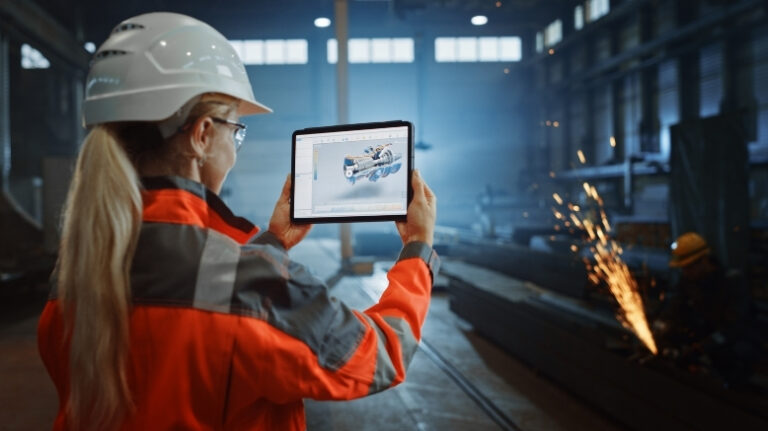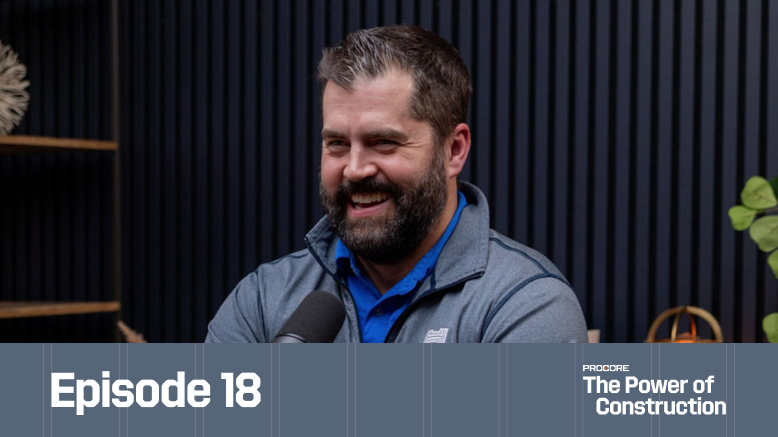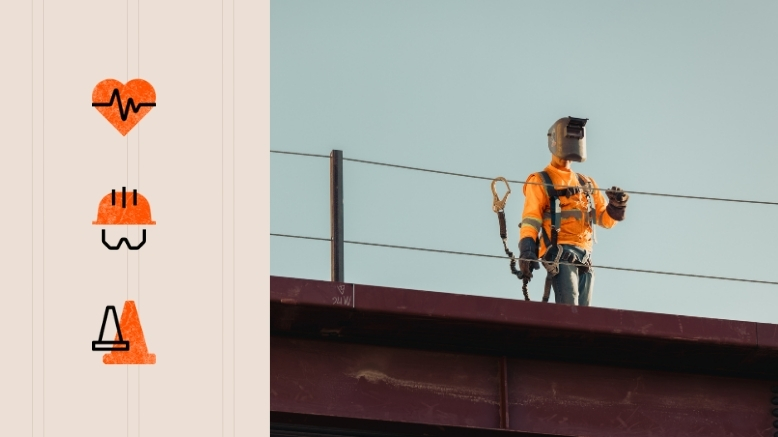— 5 min read
Gain Without Pain: Leveraging Technology for Strategic Safety Programs


Last Updated Sep 23, 2025

Jacob Kunken
Solutions Engineer, Heavy Civil
28 articles
Jake Kunken currently works as Solutions Engineer for Procore's Heavy Civil division. He brings 14 years of experience working in various construction roles in New York and Colorado, including laborer, assistant carpenter, carpenter, assistant superintendent, superintendent, construction manager, safety manager, and project manager. Jake also spent time in EHS as an environmental engineer for Skanska. He’s worked on more than 40 commercial projects from ground-up, to heavy civil, hospital work, and tenant improvement. Jake studied Ecological Technology Design at the University of Maryland.

Diane McCormick
Writer
49 articles
Diane McCormick is a freelance journalist covering construction, packaging, manufacturing, natural gas distribution, and waste oil recycling. A proud resident of Harrisburg, PA, Diane is well-versed in several types of digital and print media. Recognized as one of the premier voices in her region, she was recognized as the Keystone Media Freelance Journalist of the Year in 2022 and again in 2023.
Last Updated Sep 23, 2025

In safety, there is always room for improvement, and technology creates the ability to scale safety programs that drive risk mitigation, operational efficiencies and competitive advantage.
In fact, builders who systematically track and review injury prevention and control can reduce Total Recordable Incident Rates (TRIR) by 59 percent and Days Away, Restricted or Transferred (DART) by 60 percent, according to the Associated Builders and Contractors’ 2025 Health and Safety Performance Report.
Those kinds of numbers get attention. The MEP contractors who sidestep the exponential power of safety technology to track and analyze safety data can risk losing ground in a construction environment where expectations are set for microscopic safety rates.
This article explores how to leverage technology to systemize safety. It looks at obstacles, the safety-oriented features of existing and emerging technology and action steps for elevating safety from a set of procedures to a strategic necessity.
Table of contents
Barriers to Adopting Technology for Safety
In the rush of daily business, adopting new technology or maximizing existing technology can be a challenge. Even for a top priority such as safety, a range of issues stand in the way.
Many new technologies come with a steep and daunting learning curve. Lacking the time to ramp up or the personnel comfortable with technology, contractors find themselves falling back on old, reactive practices.
ROI is always a concern. In the short term, safety is not revenue-generating, and hefty price tags for safety equipment and software cut into profitability.
Skills gaps can also impede progress. The traditional safety director might have been a former worker who changed to walking around with a clipboard, but today’s high-level safety directors need cutting-edge data analytics skills.
Finally, there are privacy fears. Older, generalized imaging technology such as CCTV has become commonplace on jobsites, but new, individualized technology such as GPS trackers could encounter resistance. Workers might be unwilling to track themselves or be subject to constant monitoring.
Leveraging Technology for Safety Strategy
A technology-forward safety strategy adds layers of protection to every project and jobsite. The tools for methodical adoption and measurable outcomes are at hand.
Simple Systems
Teams can flatten the learning curve by searching out “set it and forget it” systems that users can plug in from Day One.
Safety Wearables
Wearable technology integrates easily into the workday by putting information gathering and dispensing on the persons working the site. Incorporated into glasses, hard hats, gloves and vests, they dispense with the task of asking people to document what they’re doing or seeing onsite. As strategy tools, they collect data for safety managers to review for trends and safety risks.
Autonomous Systems
Tech can perform the most dangerous work on today’s sites. Whether they’re taking aerial photos or entering confined spaces, drones and robots can do the jobs that endanger humans, and without the human error that causes accidents.
Preset Safety Features
Like tech tools, physical safety innovations that integrate easily into the site are the likeliest to be adopted. For example, preset D-rings in skyscraper concrete slabs encourage workers to tie off easily and efficiently. Such innovations augment digital innovations by populating the site with additional user-friendly features.
Data Analytics
Safety supervisors adept at using tools such as Power BI can sift through, categorize and analyze data. They know how to maximize pre-stocked reports to reveal trends and, at a higher level, collaborate with software vendors to customize reports to the targeted needs of the jobsite, project or company.
Anything is possible these days, but data turning into useful information is generally new for the construction industry. To learn that this muscle is available is something that needs to be promoted.

Jacob Kunken
Solutions Engineer, Heavy Civil
Procore Technologies
Building a Tech-forward Safety Program
Targeted tactics help enfold safety programs into daily operations, enabling efficiencies and data-driven decisions.
Find the ROI.
Safety investments becomes assets when calculated in the aggregate, through long-term savings accruing from fewer injuries, time saved and less spending on workers’ compensation.
Save money (and win jobs).
A strong safety track record can decrease insurance premiums and opening doors to jobs where good DART rates, TRIRs and Experience Modification Rates (EMR) are prerequisites for bidding.
If you can prove you have a long track record of safety, then you have the ability to decrease your cost of insurance. It’s like a good driving record.
Jacob Kunken
Solutions Engineer, Heavy Civil
Procore Technologies
Use tech to streamline communication.
Use technology to enhance safety by creating clarity around project needs and delivering timely alerts to safety hazards. Mobile phones allow instant outreach to safety supervisors. Voice memos and photos can capture unsafe conditions in the moment, to be addressed immediately or problem-solved later. Voice-based platforms maintain contact with workers in isolated settings.
Go virtual.
Videos and remote meetings bring new dimensions to safety training, toolbox talks and huddles. Supervisors can keep pace with safety issues while maximizing their time by joining meetings remotely. Workers can watch bite-sized, digestible training videos that take minutes, not hours, out of their days.
Free AI in Construction Course with Hugh Seaton
Start learning today with industry expert Hugh Seaton and discover how AI can boost efficiency, reduce risk, and transform your projects.

Tech as a Safety Building Block
Technology is enriching analytics systems with copious amounts of data, useful for targeting SOPs on specific pain points. A wealth of details on such safety factors as daily log compliance, incident reporting and unsafe conditions will add the strokes that create comprehensive pictures of jobsites.
As a result, MEP contractors can transform safety procedures into safety strategies that save lives and create a leaner, more agile operation fully equipped to compete in today’s construction arena.
Was this article helpful?
Thank you for your submission.
0%
0%
You voted that this article was . Was this a mistake? If so, change your vote
Scroll less, learn more about construction.
Subscribe to The Blueprint, Procore’s construction newsletter, to get content from industry experts delivered straight to your inbox.
By clicking this button, you agree to our Privacy Notice and Terms of Service.
Thank you!
You’re signed up to receive The Blueprint newsletter from Procore. You can unsubscribe at any time.
Categories:
Written by

Jacob Kunken
Solutions Engineer, Heavy Civil | Procore Technologies
28 articles
Jake Kunken currently works as Solutions Engineer for Procore's Heavy Civil division. He brings 14 years of experience working in various construction roles in New York and Colorado, including laborer, assistant carpenter, carpenter, assistant superintendent, superintendent, construction manager, safety manager, and project manager. Jake also spent time in EHS as an environmental engineer for Skanska. He’s worked on more than 40 commercial projects from ground-up, to heavy civil, hospital work, and tenant improvement. Jake studied Ecological Technology Design at the University of Maryland.
View profile
Diane McCormick
Writer | Procore Technologies
49 articles
Diane McCormick is a freelance journalist covering construction, packaging, manufacturing, natural gas distribution, and waste oil recycling. A proud resident of Harrisburg, PA, Diane is well-versed in several types of digital and print media. Recognized as one of the premier voices in her region, she was recognized as the Keystone Media Freelance Journalist of the Year in 2022 and again in 2023.
View profileExplore more helpful resources

Why Don’t We Protect the Whole Person?
Behind every safety incident is a person — and behind that person is a story we rarely ask about. Were they already exhausted before they arrived on site? Did they...

What Drives Better Safety Outcomes—Carrot, Stick, or “Zero Harm”?
On paper, construction has never looked safer. In reality, mental health claims are rising, workers are disengaged and the compliance playbook is broken. Garry Mansfield, co-founder of Scratchie, argues the...

How Close Are We to Bridging the Design-Build Divide?
For decades, construction decisions have often been made based on gut instinct. But what if the real barrier to transformation isn’t technology—it’s the divide between design and construction? In episode...

The S#*! That Can Kill You: Rethinking Safety on the Jobsite
Construction sites are full of risk — but not all risks are equal. The industry has long celebrated falling recordable injury rates, yet fatality numbers haven’t budged since around 2007....
Free Tools
Calculators
Use our calculators to estimate the cost of construction materials for your next project.
Templates
Find a template to help you with your construction project tasks.
Material Price Tracker
Get the latest U.S. retail prices and view historical trends for common building materials.
Glossary
Explore key terms and phrases used in the industry.
